In the vast tapestry of Greek mythology, Europa stands out as a captivating figure. Her tales, woven with intrigue and romance, have inspired countless retellings and interpretations throughout history.
Europa Key Facts
| Parents | Agenor and Telephassa |
| Partners | Zeus |
| Siblings | Cadmus, Cilix, and Phoenix |
| Offspring | Minos, Rhadamanthus, and Sarpedon |
| Other names | Europa |
| Roman name | Europa |
| Best Known Myth | Abduction by Zeus in the form of a bull |
Name and Etymology
Europa, has a name that’s deeply rooted in ancient etymology. Some believe the name “Europa” is derived from the ancient Greek words “eurus,” meaning “wide,” and “ops,” meaning “face” or “eye.” Thus, her name might translate to “broad-faced” or “wide-gazing.” The Romans, always keen on adopting and adapting Greek myths, also called her Europa. Throughout history, she’s been known by various epithets, each highlighting a different aspect of her persona or her role in the myths.
Europa’s Family and Relationships
Europa was born to King Agenor and Queen Telephassa of Phoenicia. She had three brothers: Cadmus, who would later found the city of Thebes; Cilix, after whom Cilicia in Asia Minor was named; and Phoenix, who gave his name to the Phoenician people. Europa’s early life was relatively uneventful, typical of a princess of her time.
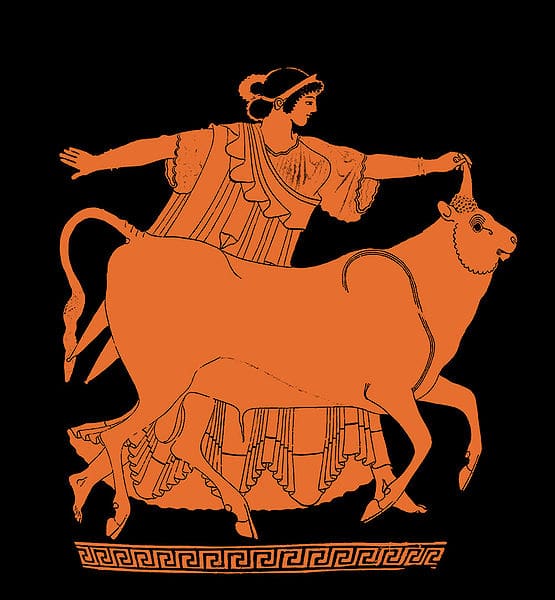
However, everything changed when the king of gods, Zeus, set his eyes on her. Smitten by her beauty, Zeus transformed into a majestic white bull and abducted her, taking her to the island of Crete. This romantic yet tumultuous relationship resulted in three children: Minos, Rhadamanthus, and Sarpedon.
Myths about Europa
Europa’s tales are deeply interwoven with the fabric of Greek mythology, with her most renowned myth being her abduction by Zeus.
The Abduction by Zeus
Europa, a Phoenician princess, was the epitome of youthful beauty and grace. One day, as she played by the seashore with her companions, a magnificent white bull approached the group. Unlike any ordinary bull, this one had a serene demeanor and eyes that sparkled with a divine glint. Drawn to its gentle nature and intrigued by its presence, Europa, after some hesitation, decided to pet it. Encouraged by the bull’s docile behavior, she eventually climbed onto its back, perhaps thinking of a short, playful ride.
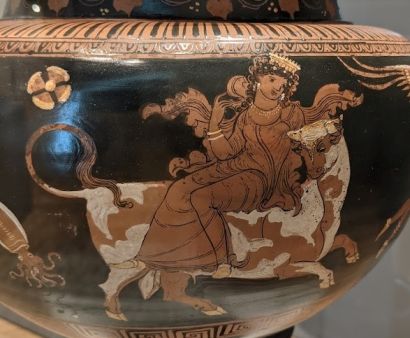
However, in a sudden turn of events, the bull, with Europa clinging onto its back, charged into the sea. It swam with great speed, crossing vast stretches of water, leaving the shores of Phoenicia and heading towards the distant island of Crete. The bull, as Europa would soon discover, was none other than Zeus, the king of the gods. He had been smitten by Europa’s beauty and, to avoid the prying eyes of his wife Hera, had transformed into this majestic creature to approach and eventually abduct Europa.
On reaching Crete, Zeus revealed his true divine form to the bewildered Europa. While the initial shock and fear were overwhelming for the young princess, Zeus’s charm and the grandeur of his divine presence were undeniable. The god of the skies and thunder wooed Europa, and she eventually became his lover. From their union, three children were born: Minos, Rhadamanthus, and Sarpedon.
This myth, while highlighting Zeus’s cunning and often impulsive nature, also underscores Europa’s significance. Her journey from Phoenicia to Crete on the back of a god-disguised-as-a-bull symbolizes the bridging of cultures and the spread of myths and legends across continents.
Depiction And Characteristics
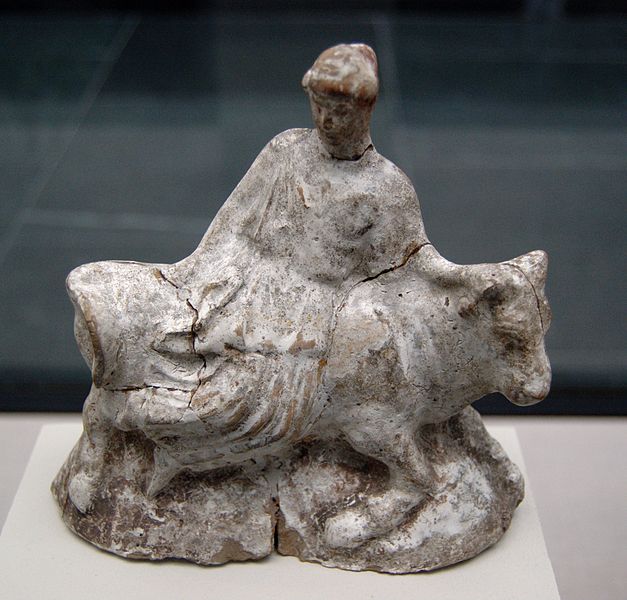
Europa’s beauty was so profound that it captivated the mightiest of gods. Often depicted as a young woman, she’s seen riding a bull across the sea, symbolizing her journey from Phoenicia to Crete. The bull, a recurring symbol in her representations, signifies Zeus’s transformation and his overpowering love for her. Europa’s personality, as gleaned from myths, paints her as a gentle, curious, and perhaps a bit naive figure. The ancient Greeks viewed her as a bridge between cultures, a symbol of unity between the East and West.
Representations Of EuropaIn Art
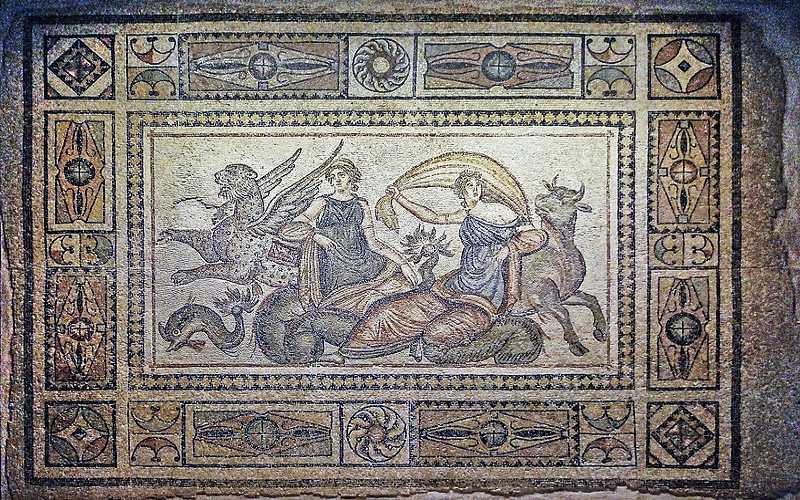
Europa’s abduction by Zeus has been a favorite theme among artists throughout history. One of the most iconic depictions is the Roman mosaic from the 2nd century AD, found in Italy, showcasing a detailed portrayal of Europaholding onto Zeus-as-the-bull. The Renaissance era, with its revival of classical themes, saw artists like Titian bringing Europa’s story to life with vivid colors and intricate details. These artworks not only celebrate her beauty but also delve into the deeper themes of passion, deception, and destiny.
Mentions in Ancient Texts
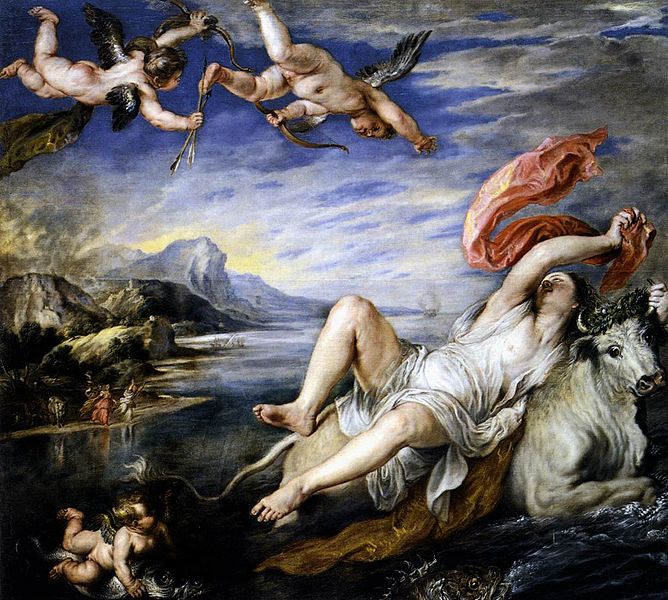
Europa’s tale has been recounted in various ancient texts, each offering a unique perspective on her story.
Ovid’s “Metamorphoses”
Ovid, a renowned Roman poet best known for his narrative poems, wrote “Metamorphoses” in 8 AD. This work offers a detailed account of Europa’s abduction. A notable excerpt reads:
“And gradually she lost her fear, and he / Offered his breast for her virgin caresses, / And then his kisses. She knew not whither / She was going, nor that the bull was Jove.”
Homer’s “Iliad”
Homer, the legendary ancient Greek poet often considered the author of the epic poems the “Iliad” and the “Odyssey,” briefly mentions Europain the “Iliad.” Written around the 8th century BC, it touches upon Europa’s lineage, hinting at her significance in the larger tapestry of Greek myths. A passage from the “Iliad” states:
“Zeus, who they say was the most glorious son of Cronus, took her to be his wife. And she, among the deathless goddesses, was called Europe.”
Moschus’ “Europa”
Moschus, a lesser-known Hellenistic poet from the 2nd century BC, dedicated an entire poem titled “Europa” to our heroine. In this work, he delves into the emotions and thoughts of Europa as she’s whisked away by Zeus. A poignant line from his poem reads:
“Alas! what land is this, what people, what city will receive Europa? The bull’s bellowing is like the sound of a Syrian flute.”
Frequently Asked Questions
Europais best known for her abduction by Zeus, who, smitten by her beauty, transformed into a white bull to whisk her away to Crete.
She had three children with Zeus: Minos, Rhadamanthus, and Sarpedon.
The continent of Europais believed to be named after her, symbolizing her role as a bridge between the East and West.
Initially, she did not. It was only after reaching Crete that Zeus revealed his true identity to her.
She was a Phoenician princess from the city of Tyre.
Europais often portrayed as a young woman, either interacting with or riding a white bull, representing her journey and the pivotal moment of her abduction by Zeus.
Featured Image Credit: Bernard Gagnon, CC BY-SA 3.0, via Wikimedia Commons
